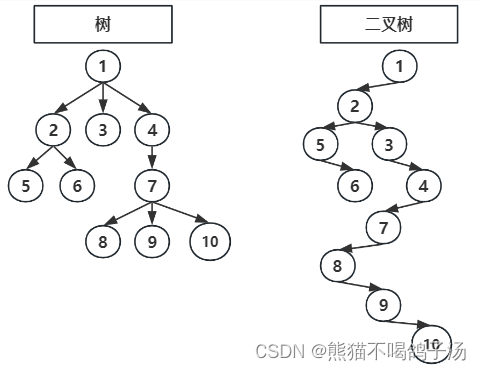前言:本文代码及解析以【双亲表示法的树】与【孩子兄弟表示法的二叉树】之间的转换为例。
- 双亲表示法——树的每个结点储存结点的值以及它指向的父节点;
- 孩子兄弟表示法——二叉树结点存储本身的值以及两个子节点,其中左孩子是该结点的首个孩子,右孩子是兄弟。如下图中,2的左孩子是5,右兄弟是3。

一、树与二叉树结构的定义
①树的定义
typedef struct TreeNode
{
int data;
struct TreeNode* parent;
} TreeNode;
typedef struct Tree
{
TreeNode tns[MAX_SIZE];
int r, n;
} Tree;②二叉树的定义
typedef struct BiTreeNode
{
int data;
struct BiTreeNode* leftChild;
struct BiTreeNode* rightBrother;
} BiTreeNode;
typedef struct BiTree
{
BiTreeNode btns[MAX_SIZE];
int r, n;
} BiTree;二者的定义类似,其中MAX_SIZE限制了结点的最大数量,r代表根的位置,n代表结点的实际数量
二、程序的整体框架
主函数:
int main()
{
//1、传入parent数组
int parent[10] = { -1, 0, 0, 0, 1, 1, 3, 6, 6, 6 };
//2、创建树并打印
Tree tree = createTree(parent);
printf("\n树:\n");
printTree(tree);
//3、将树转换为二叉树并打印
BiTree tree1 = treeToBiTree(tree);
printf("\n转换为二叉树:\n");
printBiTree(tree1);
//4、将二叉树转换回树并打印
Tree tree2 = biTreeToTree(tree1);
printf("\n转换回树:\n");
printTree(tree2);
return 0;
}自定义函数及功能:
Tree createTree(int parent[]);//用parent数组创建树
void printTree(Tree tree);//打印树
void findChild(BiTreeNode* root, Tree tree);//树转二叉树的辅助函数
BiTree treeToBiTree(Tree tree);//将树转换为二叉树
void printBiTree(BiTree bitree);//打印二叉树
void addChild(TreeNode* parent, BiTreeNode* child, Tree* tree);//二叉树转树的辅助函数
Tree biTreeToTree(BiTree bitree);//将二叉树转换为树三、parent数组创建树
Tree createTree(int parent[])
{
tree.r = 0;
tree.n = 0;
while (tree.n < 10)
{
tree.tns[tree.n].data = tree.n + 1;
tree.tns[tree.n].parent = NULL;
if (parent[tree.n] != -1)
{
tree.tns[tree.n].parent = &tree.tns[parent[tree.n]];
}
tree.n++;
}
return tree;
}parent[i]即第i个结点对应的双亲结点的位置
三、树转换为二叉树
BiTree treeToBiTree(Tree tree)
{
bitree.r = 0;
bitree.n = tree.n;
for (int i = 0; i < bitree.n; i++)
{
bitree.btns[i].data = tree.tns[i].data;
bitree.btns[i].leftChild = NULL;
bitree.btns[i].rightBrother = NULL;
}
BiTreeNode* root = &bitree.btns[0];
findChild(root, tree);
return bitree;
}将树转换为二叉树的函数:将树的节点数据复制到二叉树的节点中,并将左子节点和右兄弟节点初始化为NULL。接着找到根节点并调用findChild函数来构建二叉树的结构。最后返回转换后的二叉树bitree。
void findChild(BiTreeNode* root, Tree tree)
{
BiTreeNode* currentChild = NULL;
for (int i = 0; i < tree.n; i++)
{
if (tree.tns[i].parent && tree.tns[i].parent->data == root->data)
{
BiTreeNode* newChild = &bitree.btns[i];
if (currentChild == NULL)
{
root->leftChild = newChild;
}
else
{
currentChild->rightBrother = newChild;
}
currentChild = newChild;
findChild(currentChild, tree);
}
}
}如果一个结点的parent结点的值等于root结点的值,就将该结点currentChild作为root的左孩子;
i增加再进入循环时,root已经有左孩子,于是将第二个孩子接在左孩子的右兄弟上,将第二个孩子作为currentChild,以此类推;
同时利用递归找到所有结点的孩子。
四、二叉树转换回树
Tree biTreeToTree(BiTree bitree)
{
tree2.r = 0;
tree2.n = 0;
addChild(NULL, &bitree.btns[0], &tree2);
return tree;
}首先对第二棵树进行初始化;
然后通过递归函数addChild实现每个结点与其双亲结点的连接。
void addChild(TreeNode* parent, BiTreeNode* child, Tree* tree2)
{
tree2->tns[tree2->n].data = child->data;
tree2->tns[tree2->n].parent = parent;
tree2->n++;
if (child->leftChild != NULL)
{
addChild(&tree2->tns[tree2->n - 1], child->leftChild, tree2);
}
if (child->rightBrother != NULL)
{
addChild(parent, child->rightBrother, tree2);
}
}
以左图的二叉树为例,首先将1的双亲赋值为NULL,1有左孩子,则进入递归;
第二次进入函数后,将2的双亲赋为1,2有左孩子5,则道理同上;
同时2有右孩子3,此时注意是把3的双亲赋为1,也就是2的双亲。
五、树与二叉树的打印
5.1、信息的打印
打印树格式:
XX ->parent XX
void printTree(Tree tree)
{
for (int i = 0; i < tree.n; i++)
{
if (tree.tns[i].parent != NULL)
{
printf("%d ->parent-> %d\n", tree.tns[i].data, tree.tns[i].parent->data);
}
else
{
printf("%d ->parent-> NULL\n", tree.tns[i].data);
}
}
}打印二叉树格式:
XX:leftChild ->XX rightBrother ->XX
void printBiTree(BiTree bitree)
{
for (int i = 0; i < bitree.n; i++)
{
printf("%2d: ", bitree.btns[i].data);
if (bitree.btns[i].leftChild != NULL)
{
printf("leftChild->%4d ", bitree.btns[i].leftChild->data);
}
else
{
printf("leftChild->NULL ");
}
if (bitree.btns[i].rightBrother != NULL)
{
printf("rightBrother->%4d ", bitree.btns[i].rightBrother->data);
}
else
{
printf("rightBrother->NULL ");
}
printf("\n");
}
}5.2、二叉树的遍历方法
递归/非递归(堆栈)/层次(队列)遍历方法合集丨代码详解![]() https://blog.csdn.net/qq_74315738/article/details/139021345
https://blog.csdn.net/qq_74315738/article/details/139021345
六、总结
综上,完整代码如下:
#define _CRT_SECURE_NO_WARNINGS
#include <stdio.h>
#include <stdlib.h>
#define MAX_SIZE 20
//定义树结构
typedef struct TreeNode
{
int data;
struct TreeNode* parent;
} TreeNode;
typedef struct Tree
{
TreeNode tns[MAX_SIZE];
int r, n;
} Tree;
Tree tree;
Tree tree2;
//定义二叉树结构
typedef struct BiTreeNode
{
int data;
struct BiTreeNode* leftChild;
struct BiTreeNode* rightBrother;
} BiTreeNode;
typedef struct BiTree
{
BiTreeNode btns[MAX_SIZE];
int r, n;
} BiTree;
BiTree bitree;
Tree createTree(int parent[]);//用parent数组创建树
void printTree(Tree tree);//打印树
void findChild(BiTreeNode* root, Tree tree);//树转二叉树的辅助函数
BiTree treeToBiTree(Tree tree);//将树转换为二叉树
void printBiTree(BiTree bitree);//打印二叉树
void addChild(TreeNode* parent, BiTreeNode* child, Tree* tree);//二叉树转树的辅助函数
Tree biTreeToTree(BiTree bitree);//将二叉树转换为树
int main()
{
//1、传入parent数组
int parent[10] = { -1, 0, 0, 0, 1, 1, 3, 6, 6, 6 };
//2、创建树并打印
Tree tree = createTree(parent);
printf("\n树:\n");
printTree(tree);
//3、将树转换为二叉树并打印
BiTree tree1 = treeToBiTree(tree);
printf("\n转换为二叉树:\n");
printBiTree(tree1);
//4、将二叉树转换回树并打印
Tree tree2 = biTreeToTree(tree1);
printf("\n转换回树:\n");
printTree(tree2);
return 0;
}
Tree createTree(int parent[])
{
tree.r = 0;
tree.n = 0;
while (tree.n < 10)
{
tree.tns[tree.n].data = tree.n + 1;
tree.tns[tree.n].parent = NULL;
if (parent[tree.n] != -1)
{
tree.tns[tree.n].parent = &tree.tns[parent[tree.n]];
}
tree.n++;
}
return tree;
}
void printTree(Tree tree)
{
for (int i = 0; i < tree.n; i++)
{
if (tree.tns[i].parent != NULL)
{
printf("%d ->parent-> %d\n", tree.tns[i].data, tree.tns[i].parent->data);
}
else
{
printf("%d ->parent-> NULL\n", tree.tns[i].data);
}
}
}
void findChild(BiTreeNode* root, Tree tree)
{
BiTreeNode* currentChild = NULL;
for (int i = 0; i < tree.n; i++)
{
if (tree.tns[i].parent && tree.tns[i].parent->data == root->data)
{
BiTreeNode* newChild = &bitree.btns[i];
if (currentChild == NULL)
{
root->leftChild = newChild;
}
else
{
currentChild->rightBrother = newChild;
}
currentChild = newChild;
findChild(currentChild, tree);
}
}
}
BiTree treeToBiTree(Tree tree)
{
bitree.r = 0;
bitree.n = tree.n;
for (int i = 0; i < bitree.n; i++)
{
bitree.btns[i].data = tree.tns[i].data;
bitree.btns[i].leftChild = NULL;
bitree.btns[i].rightBrother = NULL;
}
BiTreeNode* root = &bitree.btns[0];
findChild(root, tree);
return bitree;
}
void printBiTree(BiTree bitree)
{
for (int i = 0; i < bitree.n; i++)
{
printf("%2d: ", bitree.btns[i].data);
if (bitree.btns[i].leftChild != NULL)
{
printf("leftChild->%4d ", bitree.btns[i].leftChild->data);
}
else
{
printf("leftChild->NULL ");
}
if (bitree.btns[i].rightBrother != NULL)
{
printf("rightBrother->%4d ", bitree.btns[i].rightBrother->data);
}
else
{
printf("rightBrother->NULL ");
}
printf("\n");
}
}
void addChild(TreeNode* parent, BiTreeNode* child, Tree* tree2)
{
tree2->tns[tree2->n].data = child->data;
tree2->tns[tree2->n].parent = parent;
tree2->n++;
if (child->leftChild != NULL)
{
addChild(&tree2->tns[tree2->n - 1], child->leftChild, tree2);
}
if (child->rightBrother != NULL)
{
addChild(parent, child->rightBrother, tree2);
}
}
Tree biTreeToTree(BiTree bitree)
{
tree2.r = 0;
tree2.n = 0;
addChild(NULL, &bitree.btns[0], &tree2);
return tree;
}运行结果:
树:
1 ->parent-> NULL
2 ->parent-> 1
3 ->parent-> 1
4 ->parent-> 1
5 ->parent-> 2
6 ->parent-> 2
7 ->parent-> 4
8 ->parent-> 7
9 ->parent-> 7
10 ->parent-> 7
转换为二叉树:
1: leftChild-> 2 rightBrother->NULL
2: leftChild-> 5 rightBrother-> 3
3: leftChild->NULL rightBrother-> 4
4: leftChild-> 7 rightBrother->NULL
5: leftChild->NULL rightBrother-> 6
6: leftChild->NULL rightBrother->NULL
7: leftChild-> 8 rightBrother->NULL
8: leftChild->NULL rightBrother-> 9
9: leftChild->NULL rightBrother-> 10
10: leftChild->NULL rightBrother->NULL
转换回树:
1 ->parent-> NULL
2 ->parent-> 1
3 ->parent-> 1
4 ->parent-> 1
5 ->parent-> 2
6 ->parent-> 2
7 ->parent-> 4
8 ->parent-> 7
9 ->parent-> 7
10 ->parent-> 7
D:\Cfiles\DSweek8\Debug\DSweek8.exe (进程 18280)已退出,代码为 0。
按任意键关闭此窗口. . .







 文章详细介绍了如何使用双亲表示法的树结构和孩子兄弟表示法的二叉树结构之间的转换,包括创建树、转换过程和相关自定义函数,以及如何通过parent数组实例化和打印这两种数据结构。
文章详细介绍了如何使用双亲表示法的树结构和孩子兄弟表示法的二叉树结构之间的转换,包括创建树、转换过程和相关自定义函数,以及如何通过parent数组实例化和打印这两种数据结构。














 6445
6445

 被折叠的 条评论
为什么被折叠?
被折叠的 条评论
为什么被折叠?








